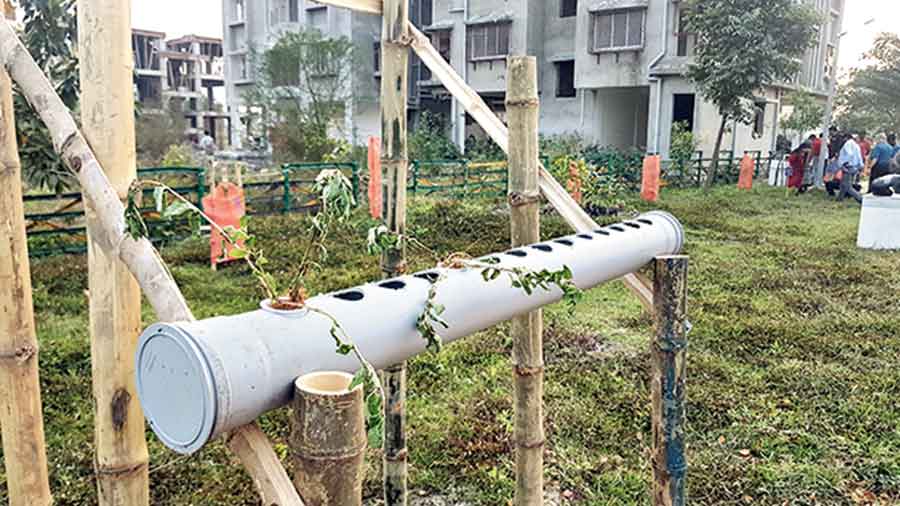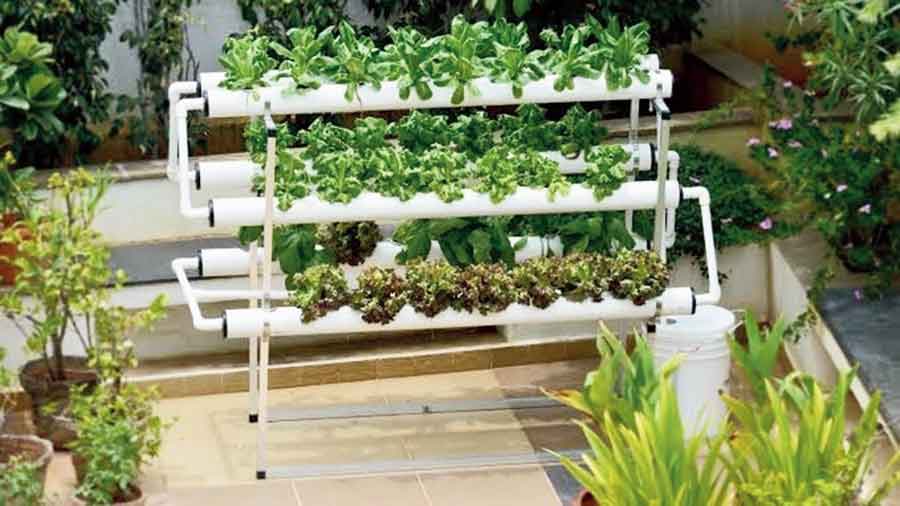A new green verge in New Town is aiming for 60,000 plants in eight months. But the plants will not be growing out of the soil. This will be a hydroponics project and the plants will all be growing out of water. That’s not all. The guardians of the park are also creating favourable conditions for bees to fly in and create honey.
Green Verge 17, next to Moonbeam complex near Akankha More, was inaugurated by chairman of NKDA Debashis Sen on February 26 and though Sen ceremoniously planted a Bakul sapling into the ground, the focus will soon shift to hydroponics.
“The system is intricate and will take time to set up. However we have a simple demonstration today,” showed Arijit Das, a member of Rotary Calcutta Newbies, that has adopted the green verge. Arijit is also the founder of Schoppen Solutions, a start-up that works on verticals like hydroponics and apiculture. He leads the beekeeping section in Eco Park that produces its own honey. His company will be implementing the infrastructure at this Rotary Garden, as it is being called.

A model on display at the inauguration
“There will be metallic structures on which will be laid multiple PVC pipes. The pipes will hold water in them and the saplings to be immersed. We shall use the ‘nutrient flow technique’ of hydroponics whereby nutrients — mainly NPK — will be flowed through the water for the roots to absorb,” explained Arijit.
There will be a mechanism to test the water every hour for its nutrient concentration, pH level etc so that alterations can be made instantly to suit the plants. “If this model is a success it can be replicated on a larger scale in villages that have poor soil fertility,” he said.
Since the plants will be growing vertically they cannot be too big. They are planning to stick to shrubs that will grow to a height of less than a foot, such as stevia (which is a sugar substitute), lavender (from which lavender oil can be extracted for aromatherapy) and other medicinal plants.
“Bee boxes will be placed and we shall strategise in a way that some plant or the other will always have flowers in bloom. That way bees will have nectar here round the year and use the man-made bee boxes here to produce honey,” Arijit explained. “We are not allowed to exploit this space commercially so the output of these plants will all be handed over to NKDA, that has provided us the space.”

What the organisers promise the structures will look like once ready
The plot will have some terrestrial trees but the lawn will not be the kind one is used to. “The trees planted here will all be flowering ones — to attract the pollinator bees — but such species take years to flower. The hydroponic plants, on the other hand, will take 45 to 90 days to flower,” explained Arijit. “As for the lawn, instead of exotic varieties like Mexican grass, we shall grow indigenous species like Lojjabati, Hatishur and Ghash Phool.”
Most people believe the above species to be weeds and yank them off their gardens in the name of clearing the ground. “But they are part of the ecosystem and often support insects, birds etc. Many exotic plants are from lands where resources are scarce and have evolved to suck in every iota of nutrient from the soil. When planted in India, they continue their behaviour and usurp all nutrients around them, leaving nothing for the indigenous plants growing around them,” he explained.
Sen said he was delighted to be inaugurating what was the 38th out of 47 green verges available in New Town. “NKDA had been trying to maintain these but it was an uphill task. So we offered it to interested parties who wanted to increase greenery. The concept of hydroponics is unique and interesting.”
Sudip Mukherjee, the immediate past district governor of the Rotary club, thanked Sen for the opportunity to fulfil their ambition of supporting the environment. “This 0.93 acres of land already has a paved walkway and solar lamps. Not only will this Rotary Park be open to the public, but we also want to host story-telling sessions for children here,” added another member Sourish Choudhury.
The knowhow
There will be metallic structures on which will be laid multiple PVC pipes. The pipes will hold water in them and the saplings will be immersed. The ‘nutrient flow technique’ of hydroponics will be used whereby nutrients will be flowed through the water for the roots to absorb.
